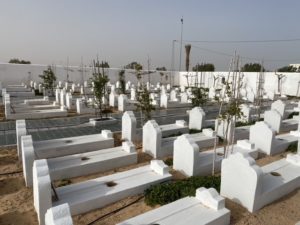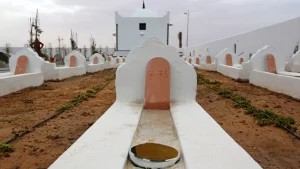Scholars are using Getty Foundation funding to draw attention to Africa’s complex influence on art and culture throughout the Mediterranean

By Carly Pippin Feb 21, 2023
Body Content
A small cemetery in southern Tunisia’s port city of Zarzis evokes ancient descriptions of paradise.
Fragrant jasmine and red bougainvillea climb trellises between headstones. Pomegranates and oranges ripen in the sun. Five olive trees represent the five pillars of Islam.
The people interred within the bright stucco walls experienced nothing like paradise in their last few hours, though. The cemetery, named Jardin d’Afrique (Garden of Africa), is a creatively designed final resting place for hundreds of migrants who drowned trying to cross the Mediterranean from North Africa to Europe.

Envisioned and constructed by Algerian artist Rachid Koraïchi, the Garden of Africa is a hopeful response to the indignity and inhumanity experienced by thousands of people, many of whom traveled from sub-Saharan Africa to escape poverty, war, political oppression, and more.
Koraïchi believed it was his duty “to make a burial ground, one with presence and intelligence, so that one day the families, the fathers, the mothers, the tribes, and the countries know that their children are in a heavenly place, the first step to heaven,” he told the Associated Press in 2021.

Get Inspired Enjoy stories about art, and news about Getty exhibitions and events, with our free e-newsletter Subscribe now
The Garden of Africa is a profound place for multiple reasons. In addition to offering dignity to those lost at sea, as an artwork the cemetery reflects a critical conversation taking place in the humanities around the relationship between Africa and Europe and the longstanding, but relatively overlooked, cultural interplay between the South and North.
Last June, a group of international scholars from Africa, Europe, and the United States visited the Garden of Africa and other key cultural and historical sites throughout Tunisia, considered a fulcrum of South-North exchange. Their objective was to explore how Africa and the wider Mediterranean world interacted during the early modern period (14th–17th centuries) and how that exchange continues today through the movement of people and ideas.

This traveling research seminar, co-organized by art historians at Harvard’s Villa I Tatti and Columbia University, was the first event of “Black Mediterranean: Artistic Encounters and Counter-Narratives,” an ambitious, multiyear Connecting Art Histories program funded by the Getty Foundation.
The ultimate goal of the program is to develop a more complex—and ultimately accurate—story of the stylistic, material, religious, and cultural influences of the South-North meridian.
What Is the Black Mediterranean?
At the nexus of Europe, Asia, and Africa, the Mediterranean has long been known as the place where East and West collide. But scholars’ new focus on the human, material, and philosophical migrations between South and North is deepening their understanding of how interdependent Europe and Africa have been for centuries.
“Cultural exchange with and within the African continent during the early globalization of trade relationships is a neglected area of research and it is precisely our objective to explore how Africans played active roles in shaping global histories,” observes Alina Payne, who is co-leading the Black Mediterranean program as the Paul E. Geier Director of Villa I Tatti, the Harvard University Center for Italian Renaissance Studies in Florence.
When Payne first arrived at I Tatti in 2015, she started a new Africa program with conferences and dedicated fellowships for African scholars that jump-started a fresh vision of art and architecture in the intercontinental Mediterranean. This vision of embracing Africa and its agency as part of the narrative of early modernity has been gaining momentum. “In the field called ‘world history,’ which has expanded greatly from around the early 1990s, Africa hardly features as a central topic of scholarship,” explained South African scholar Shamil Jeppie in an April 2019 article in American Historical Review. Jeppie, Associate Professor of History at the University of Cape Town, was a participant in I Tatti’s earlier African initiatives and returns there this spring with Getty support as a Visiting Professor.
“West Africa seems to find its place in the field mostly because of the consequences of the Atlantic slave trade. In this framing of world history, the lands beyond the coasts of Northwest Africa remain an unknown, uninteresting space. [We need to] correct this neglect of a vast expanse of geography and give events and actors agency and significance not only at the local or even regional level but well beyond it.”

From a cultural perspective, the aesthetic migration from South to North has existed for centuries. During the early modern period, for example, luxury items such as pearls, silver, adornments for shields, fezzes, Qur’ans, and Bibles frequently made their way north through trade routes from such places as Kairouan, an ancient city in Tunisia with a confluence of Christian, Jewish, and Muslim cultures. Dynasties like the Hafsids, Habsburgs, and Ottomans also fought over control of the Mediterranean waters—a struggle reflected in looted Hafsid Qur’ans and other treasures that appeared on European soil.
“Our project will include these forgotten narratives and revisit written histories of racial subordination,” says Avinoam Shalem, Riggio Professor of the History of the Arts of Islam at Columbia University who is co-leading the Black Mediterranean program with Payne. “By reexamining these accounts and combining all of Africa—from Timbuktu to Ghana to Ethiopia, Somalia, and the Sahara—we can reframe Western control of the past and instead focus on the related histories of these two continents.”
Another goal of this Connecting Art History program is to support scholars in and from Africa. In addition to welcoming Jeppie, I Tatti is hosting three other specialists in Ethiopian art and culture—two fellows and a second visiting professor. “The production of knowledge around the Mediterranean has been mostly a Western enterprise, at least since the end of the Middle Ages, and Southern scholars remain marginalized,” says Youssef Cherif, a participant in the seminar in Tunisia and Director of Columbia Global Centers | Tunis, Columbia University’s campus in North and West Africa. “The Black Mediterranean project is giving Southern scholars a platform to explain their own history using the interpretive tools of their region.”
Uniting Scholars to Reexamine Historical Narratives
The Black Mediterranean project continues this year with two traveling seminars focused on East African countries along the Red Sea. The convenings will particularly examine the millennium-long dream to connect the Mediterranean through the city of Suez to the Indian Ocean, a vision that culminated with the building of the Suez Canal in the 19th century. The cultures along these African shores and along the Nile—Egypt, Nubia, Eritrea, Ethiopia—engaged in many and various ways with the Mediterranean cultures throughout history and connected them to those of the Indian Ocean.


“The Romans were the first to think of the possibility of creating a fluid trade route to take them into the Indian Ocean,” says Shalem, who is working with Payne to design the seminar. “The creation of the Suez Canal was a moment of change that had unprecedented implications for the entire Mediterranean, and our group will explore all of that.”
Related to the exploration of this culture corridor will be a workshop this month in Florence with the visiting fellows and professors at I Tatti and several special guests to study an Ethiopian processional cross at the Bargello Museum from the 15th century, a gift from Emperor Baeda Maryam I to the church of Gorgora on Lake Tana and previously in the Medici collection. “These objects are physical evidence of the long-distance exchange networks and extensive cultural contact in the overlapping Mediterranean and Atlantic worlds,” explains Payne. “The challenges of conducting research on African diasporic objects are manifold, yet it is a good moment to be doing this. New scientific input, used in conjunction with new documentary sources, can facilitate genuine scholarly progress, allowing new information about the dating of materials, precise origins, and new understandings of craftsmanship and technique.”
Fellowships and group research activities are at the core of Connecting Art Histories, launched by the Getty Foundation in 2009 to strengthen the discipline of art history globally and increase intellectual exchange across national and regional borders. To date the initiative has supported 50 projects across the globe, all working to build intergenerational networks of scholars in parts of the world where economic or political realities have previously prevented collaboration, especially Latin America, the Greater Mediterranean, Asia, and Central and Eastern Europe.
“Getty’s Connecting Art Histories initiative has funded eye-opening research seminars for a rising generation of art historians around the world,” says Payne, who led an earlier grant project that brought together scholars from eight countries to study artistic contributions from East Central Europe to Mediterranean culture from 1300 to 1700.
Just like the Garden of Africa, which combines tragedy and hope, the history of the Mediterranean is complex, our understanding of it requiring constant reworking to arrive at fresh conclusions. With Getty support, scholars today are working together to write a more expansive and accurate history of this global nexus of cultural production.





